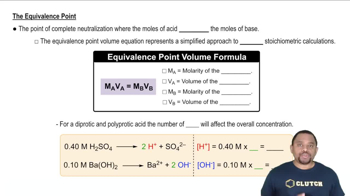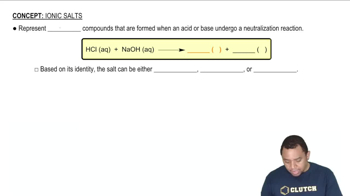A 35.0-mL sample of 0.150 M acetic acid 1CH3COOH2 is titrated with 0.150 M NaOH solution. Calculate the pH after the following volumes of base have been added: (b) 17.5 mL.
Calculate the pH at the equivalence point for titrating 0.200 M solutions of each of the following bases with 0.200 M HBr: (a) sodium hydroxide (NaOH).
 Verified step by step guidance
Verified step by step guidance
Verified video answer for a similar problem:
Key Concepts
Titration and Equivalence Point

pH and its Calculation

Hydrolysis of Salts

Consider the titration of 30.0 mL of 0.050 M NH3 with 0.025 M HCl. Calculate the pH after the following volumes of titrant have been added: (b) 20.0 mL (c) 59.0 mL.
Consider the titration of 30.0 mL of 0.050 M NH3 with 0.025 M HCl. Calculate the pH after the following volumes of titrant have been added: (e) 61.0 mL (f) 65.0 mL.
Calculate the pH at the equivalence point for titrating 0.200 M solutions of each of the following bases with 0.200 M HBr: (b) hydroxylamine 1NH2OH2.
Calculate the pH at the equivalence point in titrating 0.100 M solutions of each of the following with 0.080 M NaOH: (a) hydrobromic acid (HBr).
Calculate the pH at the equivalence point in titrating 0.100 M solutions of each of the following with 0.080 M NaOH: (b) chlorous acid (HClO2).
